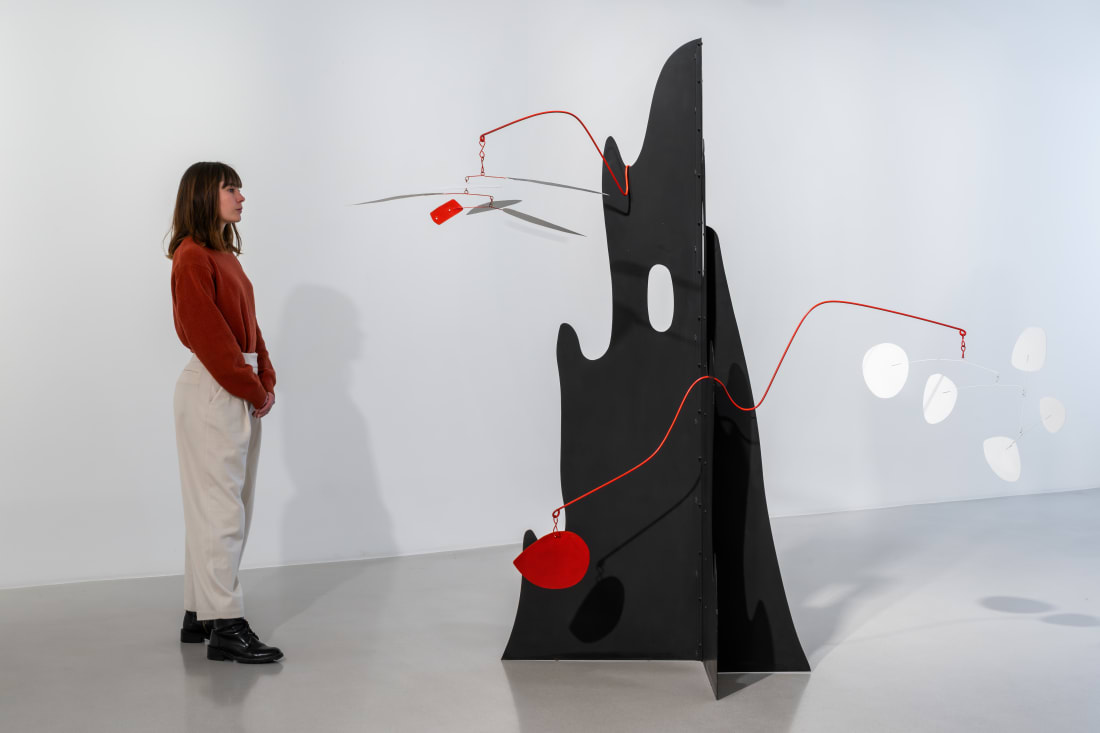

Alexander Calder Crag with White Flower and White Discs
Overview
This presentation at Thaddaeus Ropac Paris Marais highlights a focused selection of works by Alexander Calder (1898–1976). The nine gouaches on paper on view accompany one of the artist’s standing mobile sculptures, Crag with White Flower and White Discs (1974). All made during the 1970s, the works give an insight into the practice of the American artist during the final years of his life, and show another perspective on the decade at the heart of the large-scale group exhibition Expanded Horizons: American Art in the 70s, currently on view at Thaddaeus Ropac Paris Pantin until 1 February 2025.
The sculptural work Crag with White Flower and White Discs forms part of Calder’s important Crags and Critters series. The work was first shown in the year of its creation as part of the exhibition Crags and Critters of 1974, at Perls Galleries, New York, and then at Galerie Maeght, Paris, in 1975. In contrast to the creature-like Critters, the Crags, of which the work on view is an example, emerge from the ground as hyperbolic mountainous forms. Calder started making stabiles in the 1930s: so named by Jean Arp for their immobile bases placed on the ground, in opposition to his suspended mobiles. The 1974 work on view, however, contains both stabile and mobile elements, with its titular white flower and white discs suspended in perfect balance on pivoting rods that allow them to turn with the slightest current of air. In this sense, the sculpture on view represents the synthesis of Calder’s two best known taxonomies.
Calder created his first large bolted stabile fashioned entirely from sheet metal in 1937, and over the course of the rest of his life would relentlessly explore the possibilities of the medium, shaping sheet metal to form floor-bound works. The base of the sculpture on view is particularly elaborate, with its voluptuous silhouette and perforated surface coming together with the mobile elements, playful yet contemplative in their capacity for gentle movement, to suggest an imaginary landscape and its flora. Its curvaceous, organic outline is typical of the artist’s work during the period as well as a reminder of the influence of the burgeoning Surrealist movement during his time in Paris in the 1920s and 1930s. Created in the wake of the first lunar landing in 1969, it also suggests an abstracted impression of the moon’s rocky, cratered surface, bringing the Surrealists’ interest in the cosmological and astrological up to the dawn of the 1970s in a work that feels deeply engaged with the time of its making.
It may be that when the astronauts and cosmonauts, with their crude instruments, get far enough out into space to discover nonspace, shove off for another solar system only to meet themselves coming back, they will find that Calder, with his peculiar cosmic, or Universal, or Einsteinian view, call it what you will, working quietly and alone in Saché and in Roxbury, will already have anticipated them, and stated their experiences.
— James Jones, 1963
In parallel to his sculptural practice, Calder created gouaches: a medium he would return to in bursts over the course of his career, but which he would give particular focus to in his later years. The small group of gouaches on paper on view, painted between 1970 and the artist’s death in 1976, testify to several of Calder’s recurring motifs, often combining earthly and celestial landscapes: spirals and orbs, suns and pyramids. As a young man, when working aboard a ship, he awoke early off the coast of Guatemala and saw the rising sun and the setting moon on opposite sides of the horizon. ‘It left me with a lasting sensation of the solar system’, he recalled: a sensation which is felt in his work. In one of the gouaches on view, created in 1972, he depicts a dreamy landscape – perhaps the titular rade (‘harbour’) – pearled with planetary spheres. Stabiles (1973), in contrast with the other works in the group, is particularly closely related to Calder’s sculptural practice, transcribing the vocabulary of his stabiles into the more immediate medium.
Before enrolling in art school, Calder had trained as an engineer. This background can be felt in his constant, steady exploration and extension of his existing forms and ideas, always in search of new ways to adjust their tensions and balances. Calder was also one of the first sculptors to work with industrial metals, pioneering their use in artmaking ahead of the generation of artists on view in Expanded Horizons at Thaddaeus Ropac Paris Pantin, who would further explore the possibilities of the medium. Not only a trailblazer of the materials and techniques used by this younger generation in the 1970s, Calder also remained highly inventive in this last decade of his life. In this period, while devoting much of his time to monumental public commissions and his increased focus on gouache, he continued pursuing new directions for his longstanding mobile and stabile typologies. At the dawn of his final decade, Robert Osborn wrote of Calder: ‘What has been most exciting to watch is the endless change and development of his creative process. Essentially simple and direct in its approach, never pompous or bombastic, that process has allowed him the greatest freedom in seeking the various combinations and mutations of structure, form and movement. And as with any engineer worth his salt, or any artist for that matter, the endless search goes on.’



















































































































































































